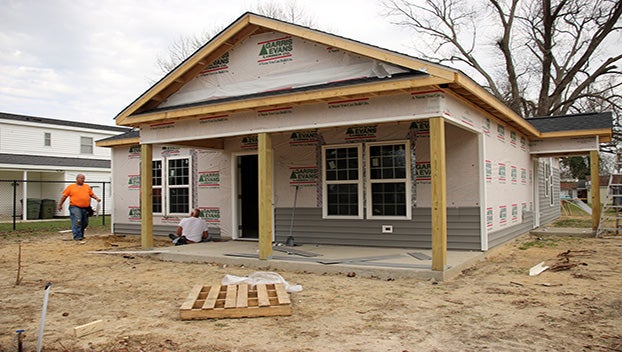Revitalization is taking shape in Washington’s inner city
Published 9:40 am Wednesday, March 1, 2023

- This home at the corner of Seventh and Gladden Streets is the first of several that are being constructed under the Neighborhood Revitalization Program which is a partnership between the Washington Housing Authority and the City of Washington that aims to provide opportunities of homeownership to low income families. (Holly Morgan/WDN)
|
Getting your Trinity Audio player ready...
|
In a few weeks, the front door of a new house built under the Neighborhood Revitalization Program will be opened to welcome the homeowner, their friends and family members.
The Neighborhood Revitalization Program (NRP) is a partnership between the Washington Housing Authority and the City of Washington. Its purpose is to restore an area in the city from East M.L.K. Jr. Boulevard to 9th Street so that homeownership for moderate to low-income families is achievable.
“You can look around here and think this area has always been rundown, dilapidated, but in its day it was a perfect blend of privileged and unprivileged living in homes that were owned,” Alice Sadler, chairman of the Washington Housing Authority’s board of commissioners said about the area at the corner of Seventh and Gladden Streets.
When the Washington Housing Authority moved into the area in the 1960’s, it brought public housing with it. As a result, streets were paved, sidewalks were built, running water and electricity were added to homes, and thermostats replaced wood and coal heaters, according to Sadler. Sadler, a Washington native, grew up near Gladden Street and remembered when Seventh Street was paved. Every kid in the neighborhood came to skate down the newly paved street, she shared.
The NRP is hoping to modernize the area again by building homes, and purchasing existing homes to renovate them.
The program started with the construction of a home at the corner of Seventh and Gladden Streets. Horton Contractors is building the 1,200 sq. ft. home which will have two bedrooms and two bathrooms. It is valued at around $180,000. The City of Washington gives a loan to the Housing Authority to help pay for the construction of the home. The Housing Authority pays the City back immediately, Sadler explained.
The lot where the home is being built is owned by the City of Washington and Washington Housing Authority. Three other homes are expected to be built on the same lot. The mission is to not only offer homeownership to moderate to low income families, but it also works to add more available homes in Washington.
Those who qualify for homeownership under the NRP can apply for types of assistance to help them maintain homeownership. There are several rate, loan and down payment assistance options available. The down payment assistance can be either $50,000 or a quarter of the total loan amount. Also, qualifying homeowners can receive a mortgage credit certificate which is a special tax credit that reduces federal income taxes every year. People who have not owned a home in the last three years can use the credit in conjunction with the North Carolina Housing Finance Agency’s down payment assistance program.
“Applicants to NRP must be current residents in the City of Washington, residents of Beaufort County, or residents of Low-Income Public Housing (LIPH) properties owned and managed by the Washington Housing Authority (WHA), participating in the Housing Choice Voucher (HCV) Program through WHA, or currently residing in Clifton Meadows, a USDA property owned and managed by the Washington Housing Nonproft Inc. (WHNI),” according to the Washington Housing Authority’s website.
“People keep saying affordable housing. Well, every house is affordable to somebody even at Moss Landing,” Sadler said, “what we’re looking at is low income families.” Most of the lending agencies who assist low income families have a maximum of 1,200 to 1,300 sq. ft. homes, she explained.
When asked how families will make house payments on homes built through the NRP, Sadler said they will receive a conventional loan specific for low income families or individuals. They can have the down payment assistance of $50,000 and finance the remaining $130,000. Tenants living in a rental property managed by the Washington Housing Authority’s housing nonprofit may transfer a voucher they use to pay rent to help pay their mortgage if they can prove they have good credit and reliable work history.
The Washington Housing Authority is not interested in “planting three or four new houses and moving on,” Sadler said. Instead, they want to assist the entire community from helping afford a home to making the area look nicer by either demolishing homes or purchasing ones that can be renovated. Sadler shared that she and her husband, City of Washington Mayor Donald Sadler, have walked the streets of the inner city and listened to citizens who say they are “elated” to hear revitalization plans.
“There are people who like this community, who like this area and once they know that we’re revitalizing the whole area and not just sticking a bunch of new houses up in the middle of what seems to be falling down around them then that will send a different message then they will have a different picture of what this is all about,” Sadler said.
In talking about the other homes that will be built, Sadler said the Housing Authority does not anticipate there being problems with having people move in. “Once people see the full vision – there was some hesitation in the beginning because of the location – if you’ve lived here, you know the community there’s not necessarily that big of a problem with the community unless you object to living near public housing.”
Sadler said she feels a “real spiritual connection” to the person who will be owning the first home built, because they are coming out of public housing to own their first home. Where they currently live is the site of Sadler’s childhood home and where she was raised.
Seeing her former neighborhood be revitalized is seeing a hope she had as a child come to fruition. “It means our inner city people, our low income people wherever they may live give them the sense that they’re worthy of a new home,” she said.
Sadler said the area surrounding Seventh Street is anticipated to be revitalized in the next couple of years. The program will continue to expand as long as funding is available.





